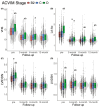Long-Term Outcomes of Mitral Valve Repair With Artificial Chordae and Annuloplasty for Myxomatous Mitral Valve Disease in Dogs
- PMID: 40525587
- PMCID: PMC12171926
- DOI: 10.1111/jvim.70171
Long-Term Outcomes of Mitral Valve Repair With Artificial Chordae and Annuloplasty for Myxomatous Mitral Valve Disease in Dogs
Erratum in
-
Erratum for "Long-Term Outcomes of Mitral Valve Repair With Artificial Chordae and Annuloplasty for Myxomatous Mitral Valve Disease in Dogs".J Vet Intern Med. 2025 Jul-Aug;39(4):e70186. doi: 10.1111/jvim.70186. J Vet Intern Med. 2025. PMID: 40705363 Free PMC article. No abstract available.
Abstract
Background: Myxomatous mitral valve disease (MMVD) in dogs commonly progresses to congestive heart failure, which carries a poor prognosis. Mitral valve repair (MVR) is a recognized treatment for advanced-stage MMVD.
Hypothesis/objectives: Identify the risk factors and prognosis in dogs undergoing MVR.
Animals: We enrolled 1019 dogs with MMVD (ACVIM stages B2, C, and D) that underwent MVR between January 2017 and December 2020.
Methods: Medical records from a single institution were retrospectively reviewed. Early and late postoperative periods were defined as < 100 days and 100-1400 days after surgery, respectively. The outcome was time to a composite of all-cause mortality, onset of postoperative congestive heart failure, or undergoing a second MVR (surgical revision).
Results: In the early postoperative period, 61 dogs experienced the composite outcome; in the late period, 211 dogs did. No dogs underwent a second MVR. The incidence rate was 19.6 and 7.1 events per 1000 dog-months in the early and late periods, respectively. Compared with stage B2 dogs, stage D dogs had 2.2 times the daily hazard of experiencing an early postoperative event. In the late period, increasing age (per year; hazard ratio [HR], 1.3), higher body weight (per kilogram; HR, 1.1), Cavalier King Charles Spaniels compared with Chihuahuas (HR, 2.2), and preoperative tricuspid valve regurgitant velocity > 3.7 m/s (HR, 2.5) were associated with the events.
Conclusions and clinical importance: A higher incidence of the event was observed in the early postoperative period rather than later, with the outcome varying according to MMVD condition and patient-specific factors.
Keywords: cardiopulmonary bypass; chordae replacement; mitral regurgitation; mitral valve insufficiency; mitral valve plasty; open heart surgery.
© 2025 The Author(s). Journal of Veterinary Internal Medicine published by Wiley Periodicals LLC on behalf of American College of Veterinary Internal Medicine.
Conflict of interest statement
The authors declare no conflicts of interest.
Figures


Similar articles
-
Assessment of Pulmonary Vein Diameters in Cavalier King Charles Spaniels with Myxomatous Mitral Valve Disease.Vet Sci. 2025 Jun 24;12(7):615. doi: 10.3390/vetsci12070615. Vet Sci. 2025. PMID: 40711275 Free PMC article.
-
Application of a Novel Mitral Valvuloplasty Strategy in Children with Mitral Regurgitation.Pediatr Cardiol. 2025 Aug;46(6):1684-1693. doi: 10.1007/s00246-024-03586-7. Epub 2024 Jul 13. Pediatr Cardiol. 2025. PMID: 38997515
-
Long-term outcomes comparison of mitral valve repair or replacement for secondary mitral valve regurgitation. An updated systematic review and reconstructed time-to-event study-level meta-analysis.Curr Probl Cardiol. 2024 Jul;49(7):102636. doi: 10.1016/j.cpcardiol.2024.102636. Epub 2024 May 10. Curr Probl Cardiol. 2024. PMID: 38735348
-
Durability of annuloplasty in patients with atrial functional mitral regurgitation associated with atrial fibrillation.J Thorac Cardiovasc Surg. 2025 Jul;170(1):177-186.e3. doi: 10.1016/j.jtcvs.2024.08.029. Epub 2024 Aug 26. J Thorac Cardiovasc Surg. 2025. PMID: 39197816
-
A systematic review and meta-analysis of chordal replacement versus leaflet resection for isolated posterior mitral valve prolapse.J Cardiovasc Surg (Torino). 2017 Oct;58(5):779-786. doi: 10.23736/S0021-9509.17.09634-3. Epub 2017 Jan 25. J Cardiovasc Surg (Torino). 2017. PMID: 28124513
References
-
- Wess G., Kresken J. G., Wendt R., et al., “Efficacy of Adding Ramipril (VAsotop) to the Combination of Furosemide (Lasix) and Pimobendan (VEtmedin) in Dogs With Mitral Valve Degeneration: The VALVE Trial,” Journal of Veterinary Internal Medicine 34, no. 6 (2020): 2232–2241, 10.1111/jvim.15863. - DOI - PMC - PubMed
MeSH terms
LinkOut - more resources
Full Text Sources
Medical

